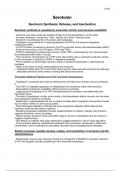Class notes
Chapter 6: Serotonin
Chapter 6 - Serotonin provides a comprehensive overview of serotonin, covering its synthesis, release, inactivation, and functional roles within the brain and body. The chapter begins with a detailed explanation of serotonin synthesis, emphasizing the conversion of tryptophan to serotonin through t...
[Show more]



